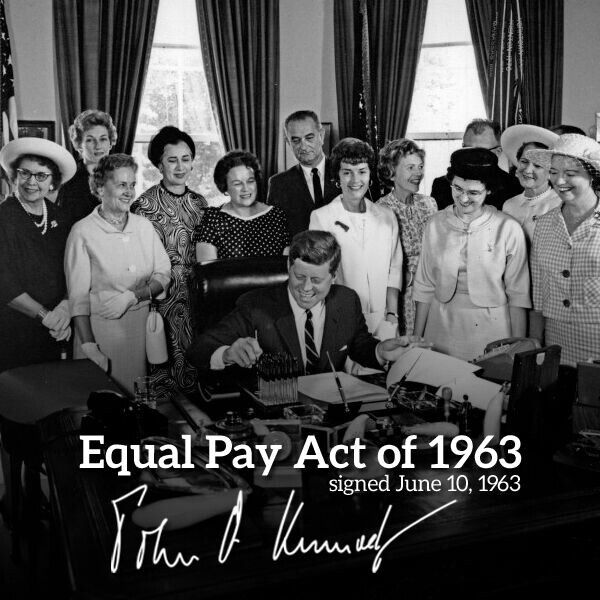In the United States of America, the gender wage gap is based on the statistic that a woman earns approximately $0.77 for every $1.00 that a man earns, but not many people understand how this figure is derived or what it even shows.1 By taking the median amount of earnings that women make in a single year and dividing this figure by the median amount of earnings that men make in a single year, the gap is revealed; however, this gap does not mean that, for the same work and qualifications, a woman will be paid $0.77 for every $1.00 that a man makes; this has been outlawed for decades: The 88th Congress of the United States passed the 1963 Equal Pay Act, which makes sex discrimination in the workforce illegal, and this law has been in effect for over fifty years.2 In addition, Harvard economist Claudia Goldin has stated that “the gender gap in wages is closing.”3 With this in mind, the question remains: why is there still a wage gap?

While it is true that there is a gap between the amount of money that men and women earn, the gap does not exist primarily because of sexism or discrimination (although this, unfortunately, is still a factor); instead, it is mainly because of the different life choices that the average man and the average woman make.
The data shows that men and women tend to go into different career fields. For example, women tend to go into the health services and social services sectors, while men tend to go into fields relating to science, technology, engineering, and mathematics (STEM).4 With regards to how the wage gap is calculated (dividing the median amount of earnings per year that a woman makes by the median amount of earnings per year that a man makes), it makes sense that there is a wage disparity if men tend to go into STEM fields while women tend to go into jobs relating to health and social services sectors.5 One could argue that more men go into STEM-related fields than women because of sexism or discrimination, and this may have been a valid point in the past; however, in recent years, the evidence reveals the opposite: women are prioritized in fields relating to STEM precisely because men tend to dominate in STEM-related careers. In fact, females are approximately two times as likely to be chosen over equally qualified men for STEM faculty positions.6 Further data from the Washington Post reveals that, even though the evidence shows that men tend to dominate in STEM fields, this is not primarily due to sexism or discrimination: “This is the latest in a series of studies by the Cornell researchers, many of which have concluded that the scarcity of female faculty in science departments (about 20 percent in most fields) can’t be blamed on innate sexism. In a study published in the journal Psychological Science in the Public Interest, they found that young and mid-career women are more likely to receive job offers than male candidates, are paid roughly the same amount, are granted tenure and promoted at the same rate (except in economics), remain in their fields for the same amount of time, and are about as satisfied with their jobs. The study attributes the lack of female scientists to early educational choices — like opting not to take Advanced Placement calculus and physics in high school or choosing not to declare a math-intensive major in college — rather than discrimination later on.”7
Regardless of where one is on planet earth, there will always be 24 hours in a day, 168 hours in a week, and 8,760 hours per year. Even though these numbers are the same for everyone on earth, everyone uses them differently in the workweek. For example, the average man working full time works 8.2 hours per day, while the average full-time woman works 7.8 hours per day. If men and women are compared further (without taking into account part-time work), then it’s revealed that men tend to work an average of 42 more minutes than women; although 42 minutes might not seem like much time, it does translate into many hours in the long run: an additional 42 minutes per day at work means that men, on average, are working 3.5 hours more than women per week, or an additional 14 hours per month.8 This extra amount of time means that men will be paid more money than women, since, on average, they work more than women. With this in mind, when calculating the earnings of women compared to the earnings of men, the disparity in wage makes sense.
Why is it that there is a vast disparity between the men and women in professional sports in the United States of America? The median salary for a player in the National Basketball Association (NBA) in 2015 was $2,505,720.9 The median salary for a player in the Women’s National Basketball Association (WNBA) is approximately $71,635.10 Even though both a woman from the WNBA and a man from the NBA are playing the same game, why is there a massive gap in the amount of money made? It appears that the answer can be derived from economics. With regard to economics, there are two forces at play: the law of supply and the law of demand. The law of demand states that there is an inverse relationship between price and quantity demanded.11 In other words, the more expensive a product becomes, the less likely consumers are to purchase it. The law of supply states that there is a positive relationship between price and quantity supplied.12 This means that if a supplier of a product realizes that the demand for a product is high, then the supplier can charge more money because he or she knows that people will pay for the product. Because the NBA knows the demand to see their games is high, the supplier (the NBA) can charge a lot of money for their tickets. On the other hand, the WNBA is not as popular compared to the NBA. Because the demand for WNBA games is not as high as NBA games, the supplier cannot charge as much money compared to the NBA, which means that the WNBA players will not make as much as NBA players. Another reason why NBA players tend to make more money is that their season is 82 games, while the WNBA players’ season is only 18 games; this means that there is more time for money to be collected for NBA players than in the WNBA. As can be seen, the disparity in money from an NBA player’s salary and a WNBA player’s salary has little to do with sexism or discrimination and everything to do with the way economics works.

It seems that the wage gap is primarily a product of multiple factors, such as the choice of job that the average man or the average woman takes, the number of hours that the average man and the average woman works, and because of economics. Having said this, what happens when these factors are accounted for? If the equation to find the gender wage gap accounts for these variables, then there is a small disparity between the amount of money that a man makes versus the amount of money that a woman makes. This small disparity seems like, unfortunately, a product of sexism and discrimination. One major form of discrimination in the workforce that women face is vertical (or hierarchical) segregation, which “refers to the fact that men are much more likely than women to be in positions of authority.”13 However, the United States government and businesses have begun to take notice of this and are now trying to do their best to reduce this form of discrimination. For example, women now own approximately half of all the United States companies.14 Also, President Barack Obama signed the Lilly Ledbetter Fair Pay Act in 2009, which made it much more difficult for businesses to take advantage of women by not paying them their fair share.15 This shows that, while discrimination and sexism play a role in a part of the wage gap, it is, thankfully, dying out and becoming less and less of a problem.

The gender wage gap is a complex issue. While it is still a problem in the United States of America, great strides are being made to reduce it. The gender wage gap appears to have multiple components, such as the amount of time working, the jobs that men and women go into, and, in part, economics. However, after accounting for this, there seems to be a percentage of the wage gap that doesn’t disappear; this percentage seems to be derived from sexism and discrimination. With this said, there is hope: laws have been passed in recent years to combat this unfortunate case of sexism and discrimination, and the workforce is more pro-women than at any other point in the history of the United States of America.16 Additionally, there is a global effort to reduce the inequality between man and woman: The United Nations adopted the Universal Declaration for Human Rights in 1948, which states that everyone has the right to equal pay for the same work.17 Although it is unfortunate that there is still a wage gap, there is a good trend in America with regards to the gender wage gap: it is decreasing. Hopefully, one day, the wage gap will be a thing of the past.
- Encyclopedia of Social Problems, 2008, s.v. “Wage Gap,” by Vincent N Parrillo. ↵
- The Wiley Blackwell Encyclopedia of Family Studies, 2016, s.v. “Gender Wage Gap,” by Emira Danad. ↵
- Reihan Salam, “Which Gender Gap?” National Review 66, no. 1 (January 27, 2014): 19-20. ↵
- “Students in STEM Fields by Gender and Race/Ethnicity,” CollegeBoard, https://trends.collegeboard.org/education-pays/figures-tables/students-stem-fields-gender-and-race-ethnicity. ↵
- Kerry Close, “STEM Majors Will Earn Highest Salaries This Year,” Time, January 21, 2016, http://time.com/money/4189471/stem-graduates-highest-starting-salaries/. ↵
- Ted Boscia, “Women Preferred 2:1 Over Men for STEM Faculty positions, “Cornell Chronicle, April 13, 2015, http://news.cornell.edu/stories/2015/04/women-preferred-21-over-men-stem-faculty-positions. ↵
- Sarah Kaplan, “Study Finds, Surprisingly, That Women Are Favored for Jobs in STEM,” The Washington Post, April 14, 2005, https://www.washingtonpost.com/news/morning-mix/wp/2015/04/14/study-finds-surprisingly-that-women-are-favored-for-jobs-in-stem/?noredirect=on&utm_term=.1be2c8a73649. ↵
- Karin Agness, “New Report: Men Work Longer Hours Than Women,” Forbes, June 30, 2016, https://www.forbes.com/sites/karinagness/2016/06/30/new-report-men-work-longer-hours-than-women/#7166f2e518b4. ↵
- Tome Gerencer, “How Much Money Does an NBA Player Make?” Money Nation, November 13, 2016, http://moneynation.com/how-much-money-does-an-nba-player-make/. ↵
- Paulana Lamonier, “The Business Of Being A WNBA Player,” Forbes, July 2, 2018, https://www.forbes.com/sites/plamonier/2018/07/02/the-business-of-being-a-wnba-player/#11d4d5c35af1. ↵
- Timothy Taylor, Courseware Print Companion for Micro Economics (unknown, 2016), 19. ↵
- Timothy Taylor, Courseware Print Companion for Micro Economics (unknown, 2016), 20. ↵
- Encyclopedia Britannica, 2018, s.v. “Gender wage gap,” by Medora W. Barnes. ↵
- Williams G. Nickels, James M. McHugh, and Susan M. McHugh, Understanding Business 12th Edition (New York: McGraw-Hill Education, 2016), 130. ↵
- From Suffrage to the Senate: America’s Political Women, 2013, s.v. “Lilly Ledbetter Fair Pay Act of 2009,” by Suzanne O’Dea. ↵
- Bryce Covert, “Closing the Wage Gap for Women,” New Republic, no. 249 (July 2018): 4-6. ↵
- Gale Encyclopedia of U.S. Economic History, 2015, s.v. “Gender Wage Gap,” by Ermira Danaj. ↵



44 comments
Claudia Sanchez
Loved the structure of this article! I had heard a lot about the wage gap but never got any explanation for it. To the uninformed, it seems as though women are paid less for the same word, which as this article points out isn’t the case. This article was very informative and changed the way I see the Wage gap. I liked though that this article acknowledged that there is, in fact, a wage gap, but it is not for the reason most people think. i posted this comment already i hope it counted it
Claudia Sanchez
Loved the structure of this article! I had heard a lot about the wage gap but never got any explanation for it. To the uninformed, it seems as though women are paid less for the same word, which as this article points out isn’t the case. This article was very informative and changed the way I see the Wage gap. I liked though that this article acknowledged that there is, in fact, a wage gap, but it is not for the reason most people think.
Maria Martinez
The gender wage gap is brought up a lot in politics and social media, and it is usually always described as being an issue that has not gotten better. This article really did a great job at giving facts about where exactly the gender wage gap is coming from and how as a society we can take the steps to further push the gap into nonexistence. Including all of the factors that go into the gap that don’t involve sexism or discrimination was a great use of facts, I honestly never knew that such a ‘big’ issue could stem from such small decisions women make early on in their academic careers.
Diego Terrazas
The gender wage gap has always peaked my interest. At the first hearing of it, I (like many) thought that men earned more than women because of gender discrimination, but after looking into it I realized why the gap was there (or the basics of why). This article does well to state what the gender gap is and some issues with it. I hope that others will take a moment of their time to read it.
Michael Leary
This article was very informative because the popular media often pushes the idea of this sexist gap that prevents women from advancing in the workplace. It was interesting that the problem, as pointed out, is that it is a multifaceted problem, partly attributed to the general difference in the field that they enter and the amount of hours a day worked.
Krystal Rodriguez
I cant believe that in this day in age women still get payed less than men for doing the same job. The fact that even women in sports who do the same thing men do dont even make half what men make. Male basketball playes are idolized and make millions every year while women basketball players are hardly even recognized. I also feel like men always want to say the wage gap isnt real but the reality is that women just dont get payed the same as men and sometimes will be overlooked for a job just because they are women.
Christopher Hohman
Nice article. The gender wage gap is not as big as I thought it was. This article did a great job in discussing the different factors that go into determining a man’s wage vs a woman’s wage. I was glad to hear that actual discrimination based on gender is declining, and that both the United States government and the United Nations have taken steps to close the gender wage gap in recent decades. I do hope that one day we will be able to look back on the gender wage gap and see it as a thing in the past.
Mariah Cavanaugh
In your article you mention Claudia Goldin and the studies she conducted. In those studies, she also mentions that during a women’s twenties and thirties is when the pay gap is the widest compared to men. This is due to the fact that women are still expected to be the primary caregivers to the children. This means a woman is taking care of the children while men are continuing to work and further their career.
Danniella Villarreal
It goo dot know that the wage gab is started to get smaller, but there are so many different views to this topic. For example if women got paid less then men then wouldn’t companies hair more women sense they wouldn’t have to pay them as much? This article brings a lot of attention to the different view points and gives useful information on to why the wage gap is still a problem.
Isaiah Torres
I do not believe that there is a wage gap in the United States based on gender. Statistically showing that women actually make more in the same job as men if their education level is equal or higher. But let’s all take a second and think about it, if the workforce has the gap like people say, then many places would fire the men and only hire women becuase they would save more money because of paying women less. They also make less money because also statistically showing, women take less risky jobs, and the more risky the more money you make. Men typically take these jobs becuase it was their choice, and women choose not to do so. I liked the part with the NBA compared to the WNBA becuase ive actually used the example before. If the organization is making $50,000 a season, there’s no way they can pay the player even close to $50,000 becuase that’s what the whole organization makes. The NBA makes hundreds of millions, and that’s what the players make. It makes sense in any example and in any comparison with any type of career.